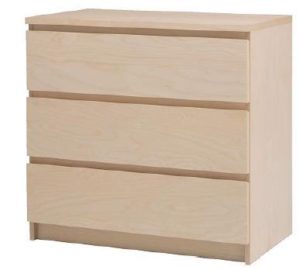Thinking about getting a new flat-screen TV for the holidays, or a dresser for the baby’s room? Factor safety into your choice.
The U.S. Consumer Product Safety Commission warns TVs and furniture like dressers and chests pose tip-over risks if they are not properly anchored to walls. This is especially true in households with young children, who can be tempted to climb on anything. But plenty of adults get injured, too.
Emergency rooms treat an average of 30,700 people – 52 percent of them children – each year for injuries related to falling televisions, furniture and appliances, according to a 2017 CPSC report. Between 2000 and 2016, 514 people were killed by tip-overs, more than 80 percent of them children.
The CPSC’s “Anchor-It!” campaign encourages families to attach TVs and top-heavy furniture to walls.
“The holidays are a time when households are very busy,” said Ann Marie Buerkle, acting chairman of the CPSC. “This is really kind of a hidden hazard.”
With that in mind, here are some things to consider while shopping.
WHERE TO PUT IT?
Take a look at the room where you want the item to go. What kind of walls does it have? In most homes, bedrooms have sheet rock walls, making it relatively simple to install anti-tip devices. It’s just a matter of finding the studs and following the instructions properly.
Things get more complicated if you have an older home with plaster or brick walls. Stud finders are useless for plaster walls and drilling into brick can be tricky. That might mean a dresser may have to go against another wall than the one you had in mind. So, take that into account before settling on the size and shape of a dresser.
If plaster or brick walls are the only option, consider hiring a professional to avoid mistakes that will leave a bunch of holes, said Peter Kerin, owner of Minnesota-based Foresight ChildProofing, Inc.
Keep the same considerations in mind for old furniture or TVs that might get moved to make room for the new piece. Many families end up putting old TVs on top of furniture not meant to hold it and then forget to anchor it, Buerkle said.
READ UP ON SAFETY STANDARDS
Most American furniture manufacturers adhere to safety standards developed by ASTM International for a wide range of products. Manufacturers’ compliance is voluntary, however. Ikea has recalled more than 17 million chests and dressers that didn’t meet the standards, after eight children were killed by toppled Ikea furniture. The Swedish retailer says it no longer sells furniture in the U.S. that doesn’t meet the standards.

Dressers must pass two stability tests to meet the standards. The first requires the piece not to tip over when all drawers are opened to the “stop,” or two-thirds of the way if there is no “stop.” The furniture also must not tip over when all of its doors are opened 90 degrees. For the second test, the furniture must not fall over when a 50-pound weight – the average weight of a 5-year-old – is gradually applied to the front of the drawer. The furniture must also be sold with anti-tip restraint kits.
Check to see if the furniture has a permanent tip-over warning label attached, usually inside the top drawer. That will let you know it adheres to the standards.
If you are buying furniture online, avoid any product that does not specifically say it meets the standards, says Pat Bowling, vice president for communications of the American Home Furnishings Alliance.
There is also no need to blow your budget. Furniture that complies with the ASTM guidelines is widely available in all price ranges, Bowling said.
MAKE SURE YOU HAVE ALL THE HARDWARE YOU NEED
Most new furniture comes with anti-tip restraints and instructions for installing them. But don’t forget about the older furniture or TVs in your home. Anti-tip brackets are available at hardware stores, major big-box retailers and online. A stud finder and a drill are also a good idea.
Look for restraints that are detachable, for easy cleaning, and that comply with their own ASTM standards . Kerin says he prefers metal buckle and nylon straps but the most important thing is to install them properly. For furniture, make sure to put the screws into solid wood, rather than the thin paneling usually found on the back.
Was this article valuable?
Here are more articles you may enjoy.

 ‘Super Roofs’ Are Rewarding Insurers, Cat Bond Investors and Homeowners
‘Super Roofs’ Are Rewarding Insurers, Cat Bond Investors and Homeowners  Standard Chartered Settles $2 Billion Iranian Sanction Suit in London
Standard Chartered Settles $2 Billion Iranian Sanction Suit in London  State Farm Sued Over Policies Backed by Distressed Insurer PHL
State Farm Sued Over Policies Backed by Distressed Insurer PHL  Truckers Who Fail English Tests Get Pulled Off Roads in Trump Crackdown
Truckers Who Fail English Tests Get Pulled Off Roads in Trump Crackdown 